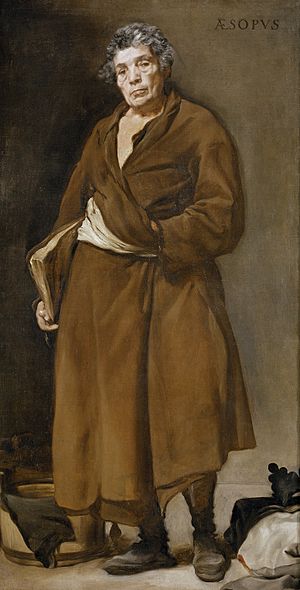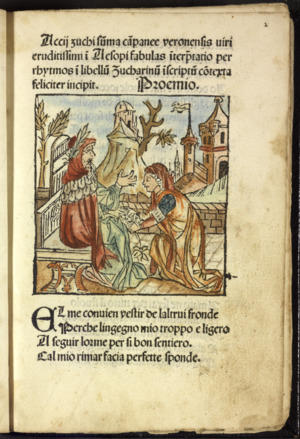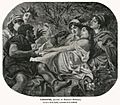Aesop facts for kids
Quick facts for kids
Aesop
Αἴσωπος (Aisōpos) |
|
|---|---|

Aesop, as depicted in the Nuremberg Chronicle
|
|
| Born | c. 620 BC |
| Died | 564 BC (aged c. 56) Delphi, Greece |
| Nationality | Greek |
| Genre | Fable |
| Notable works | Number of fables now collectively known as Aesop's Fables |
Aesop (pronounced EE-sop) was a famous storyteller from Ancient Greece. He is known for his many short stories called fables. These fables often teach a moral lesson.
People believe Aesop lived around 620 BC to 560 BC. He was traditionally thought to be a slave, possibly from Africa. His fables are still popular today. They are used to teach important lessons and are often turned into plays or cartoons for children.
No one knows for sure if Aesop wrote all the fables himself. He might have collected them from other storytellers. His most famous fable is probably The Lion and the Mouse.
Aesop's stories often feature animals or even objects that can talk. These characters act like humans, solving problems and showing different personality traits.
It is believed that Aesop was eventually freed from slavery. Sadly, tradition says he died violently in Delphi. Because there is not much proof about his life, some people even wonder if he truly existed.
One of his most famous fables is about the tortoise and the hare. In this story, a speedy rabbit challenges a slow tortoise to a race. The rabbit is so sure of winning that it takes a nap or too many breaks. The tortoise, even though slow, keeps going steadily and wins the race. This story teaches us that "slow and steady wins the race."
| Top - 0-9 A B C D E F G H I J K L M N O P Q R S T U V W X Y Z |
Who Was Aesop?
The exact place where Aesop was born is not known. Many places claim to be his birthplace. These include Thrace, Phrygia, Egypt, Ethiopia, Samos, Athens, Sardis, and Amorium.
Some modern writers think he might have been from Africa. This idea comes from his name, "Aethiopian," which Greeks used for dark-skinned people from Africa. Also, many animals in his stories are found in Africa, not so much in Greece or Europe.
Aesop is even mentioned in an old Egyptian myth. This myth is called "The Girl and the Rose-Red Slippers." It is thought to be one of the first Cinderella-like stories. In this tale, a freed slave named Rhodopis says that Aesop told her many wonderful fables. They were both slaves on the island of Samos.
According to the historian Herodotus, Aesop died a violent death. The people of Delphi were responsible, but the reason is not clearly stated.
The Aesop Romance
There is an old story about Aesop's life called The Aesop Romance. It is a fictional biography, meaning it is not entirely true. This story was written around the 2nd century CE. Like other folk stories, it was changed and retold many times.
In The Aesop Romance, Aesop is described as an ugly slave from Phrygia. He lives on the island of Samos. At first, he cannot speak. But after being kind to a priestess, a goddess gives him the gift of speech. She also gives him a talent for clever storytelling.
Aesop uses his storytelling to help and sometimes trick his master, Xanthus. He even embarrasses Xanthus in front of his students. Later, Aesop becomes free and travels to different places. The story ends with Aesop going to Delphi. There, he makes the citizens angry with his fables. They sentence him to death, and he is forced to jump to his death.
Aesop's Fables Collection
Aesop's Fables is the name given to a collection of stories. These stories are all believed to have come from Aesop. The term "Aesop's Fables" also refers to any group of short fables. These usually feature animals that act like people.
The fables are still very popular for teaching children about morals. Many stories from Aesop's Fables are known worldwide.
- The Fox and the Grapes: This story gave us the saying "sour grapes."
- The Tortoise and the Hare: This teaches us about perseverance.
- The Shepherd Boy and the Wolf (also known as The Boy Who Cried Wolf): This fable warns about lying.
Images for kids
-
Aesop (left) as depicted by Francis Barlow in the 1687 edition of Aesop's Fables with His Life
-
Example of a coin image from ancient Delphi thought by one antiquarian to represent Aesop.
-
Aesop shown in Japanese dress in a 1659 edition of the fables from Kyoto
-
The Beautiful Rhodope in Love with Aesop, engraving by Bartolozzi, 1782, after a painting by Angelica Kauffman
See also
 In Spanish: Esopo para niños
In Spanish: Esopo para niños










